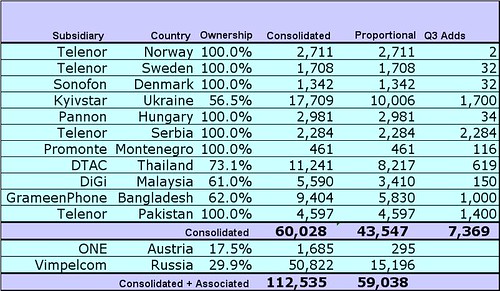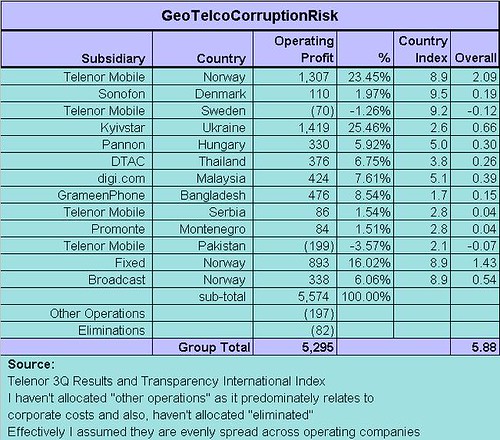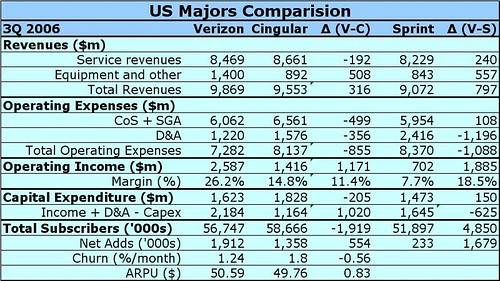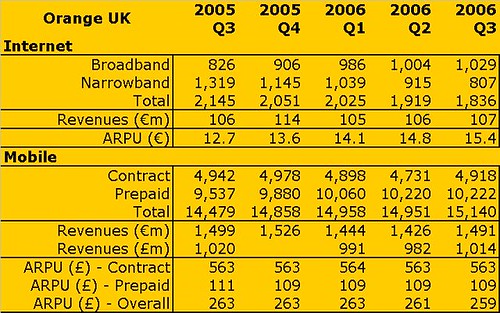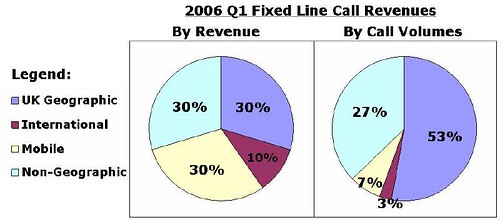After Vodafone’s surprise dropping of a major bomb into the heart of the Carphone Warehouse Territory last Thursday, there have been many column inches written and many an insult exchanged. Tonight, I thought it would be worthwhile to review a few of the key events and try to look ahead to the likely outcome.
1. Vodafone Build-Up
Enders Analysis seem to think that Vodafone’s actions in dropping Carphone and signing an exclusive arrangement with Phones4U was done in a fit of pique. Unfortunately for Carphone, I think Vodafone’s battle plan has been carefully thought through and the timing of the AOL deal presented a perfect opportunity for Vodafone to inflict some serious pain.
The first signs of something being afoot were when Vodafone dropped dial-a-phone back in October 2005 as part of a review of dealers and distribution channel. The rationale was simple enough: dial-a-phone weren’t delivering enough profitable customers. Vodafone had been with dial-a-phone since its’ launch in 1996 and dial-a-phone had delivered a lot of volume over the years to Vodafone. Next came the exceptionally fast dropping of The Link in August this year after the purchase of the troubled retailer by O2, again the rationale given that this was part of a wider review of Vodafone’s indirect business. Next was the revamp of 100 of the Vodafone Stores costing £15m in June 2006. Just last week news leaked that Vodafone Retail had changed its’ staff commission schemes and the Retail Chief had issued a memo called “Six Steps to Success” and staff been told to match the Carphone Warehouse and Phones 4u deals where necessary. Obviously, the Vodafone Stores are in the middle of a big change in direction in the middle of a big reorganization of the Vodafone Consumer Sales Distribution Channels.
Vodafone announced new prepay and postpaid tariffs for the consumer segment in June, August and September. The tariffs had become severely out-of-date and people (myself included) were wondering whether Vodafone were serious in the consumer segment. The prepay tariffs are supported by widespread advertising campaign, whereas all is quiet so far on the post pay tariffs. Obviously, Vodafone had not given up on the consumer market.
Vodafone announced today its’ Christmas handset range with a lot of exclusives from the major handset manufacturers. Both Carphone and Phones4U would have been aware of the handset range and the new distribution strategy when evaluating whether or not to sign up for the exclusive deal.
The final sign is the various senior management changes that have occurred over the last few months:
• April 2006 – Nick Read CEO UK. Read had been responsible for the declining market share of consumer segment since 2003. Perhaps, it was realized that historically he was fighting with his hands tied round his back and he had a plan for increased market share and profitability.
• Oct 2006 – Vittorio Coloa CEO Europe. A successful background in Italy where high SACs do not feature in the business model.
It is also important to note that none of the original vanguard of Gent, Horn-Smith and Bamford who had seen Charles Dunstone grow-up and build a powerhouse business was around anymore.
2. Propaganda Battle
John Pilger has an interesting twist on an old quote:
“The oldest cliché is that truth is the first casualty of war. I disagree. Journalism is the first casualty. Not only that: it has become a weapon of war…”
Almost straight after the Vodafone announcement came the leaked details of the Andrew Harrison memo where he claimed that the big losers in whole of this was Phones4U who had sacrificed their independence and Carphone had maintained its’ integrity by turning down the deal. Obviously, some rallying of the troops was necessary but this was ridiculous. Even more ridiculous was how many members of the press believed that Carphone were truly independent and not pushing products from whichever operator was paid them the highest commission. Vodafone does not seem to have regained the moral high game and has been on the back foot ever since.
PR Score: CPW 1 VODA 0Next came the comment from Roger Taylor, the CFO of Carphone: "It does not change our forecast one penny. Every Vodafone customer who comes into our stores now will not walk out on a Vodafone contract. Obviously, the heart of this was the thinking: “We, CPW are more powerful in the marketplace than Voda”. Orange came straight out and said they looking at its’ distribution strategy, again this was squashed with an “industry insider saying Orange comments were “sabre rattling” and then had just signed a new contract. By the weekend the truth was coming out: Peter Erksine CEO of o2 had said it was a wonderful opportunity to revise its’ costs downwards; Orange denied they had signed a new contract; T-Mobile seemed to express support; non-one bothered asking H3G UK. Obviously, the CFO had managed to convince the stock market that the Carphone business model was not going in tailspin and therefore stabilized the share price whereas the real consequences came to realization over the weekend – there would be a lot of pressure on CPW margins.
PR Score: CPW 1.5 VODA 0.5.I think implied in most of the press coverage is that Vodafone may regret its’ decision because it could lose market share. Unbelievably, in yesterday’s FT, it was suggested that Vodafone may re-hire Carphone in a years time when the Phones4U contract expires (fair enough); that the battle could extend to Germany, Ireland, Netherlands, Portugal and Spain (fair enough); and that Carphone can ride a big fall in its’ profits more comfortably than the Vodafone management can ride a big fall in its’ European subscriber base (total nonsense). PR Victory, but total spin – I don’t believe for one second that the Vodafone management believes UK market share will fall, let alone European.
PR Score: CPW 2.5 VODA 0.5.I believe the biggest gaffe of the PR battle was in fact made by the master himself, Charles Dunstone, when he was quoted in the FT on Saturday as saying: “This might sound flippant as the largest shareholder but I don’t really care about the share price. It’s a whole lot of people trying to predict the value of second-hand bits of paper” I’m pretty sure that this statement will come back to haunt Charles Dunstone in the future.
PR Score: CPW 2.5 VODA 1.5. Apart from the odd own goal, I believe that Carphone is slaughtering Vodafone in the media. But does it really matter? Wallets are going to win this battle not hearts.
3. Relative Financial Firepower
I felt a bit sorry for Geoff Ruddell, the Retail Analyst from Morgan Stanley, because there will be literally hundreds of sell-side telecom analysts rolling in the aisles thinking that someone actually believes that CPW have more firepower than Vodafone. Even worse, he may have planted the Armageddon Seed in the Vodafone Europe CEO’s mind – let’s do a scorched earth policy throughout Europe this winter – double bonus - Carphone and Sarin will be buried at the same time! (only slightly joking)
Vodafone UK had a turnover in y/e Mar 2006 of £5bn with operating profit of £700m (including in that is £333m of 3G license amortisation). Vodafone doesn’t disclose the FCF of the UK operation, but overall for the group it was £6.4bn. Vodafone also doesn’t disclose the split between business and consumer in the UK but rumours indicate that business accounts for circa 80% of UK revenues.
Carphone Warehouse in the same period had a turnover of £2.9bn and Operating Profit of £87m. Unfortunately for Carphone comparisons get worse from there with Free Cash Flow not being divulged. I did a quick analysis and CPW generated net cash from operating activities of £183m, but £199m (before M&A) went out the door in terms of fixed asset additions, intangibles such as SAC’s and interest payable giving an approximate free cash flow of approximate negative £16m, which is really bad because the underlying business is not generating enough cash to pay off debts. Cash M&A Costs of £158m are not so bad as long as the bank agree and the assets will produce cashflow – AOL in its’ current form seemingly doesn’t. Net debt during y/e 2006 increased from £68m to £273m. In the first half of the year CPW have been investing heavily in the broadband so I’d be extremely surprised if the net debt has decreased at the interim stage. We need to add to this the recent acquisition of AOL for £370m (£250m cash at completion). So net debt + non-operating commitments will be around £650m at the interim stage. This is a huge increase in leverage for a company which makes net such small margins.
There is another gem which is buried in the Carphone Accounts and this is the level of Sales Provisions which have increased from £28.8m to £67.4m (as at 1st April 2006). Sales provisions predominately relate to “cash-back” type deals. In other words Carphone hold a substantial portion of Customers money to fund its’ operations. This is not the time or place to discuss the relative merits of cashback deals and the badwill that it generates in the customers eyes. It seems the whole of Carphone online operations is supported by cashback deals. An operator could do serious immediate damage to the Carphone business model by not permitting them to do cashback deals.
Debt and Small Margins are the Achilles heels of Carphone Warehouse.
4. Fellow Mobile Players
All the major cellular networks in the UK are part of multinational telecom-operators who can easily see how the various business models in the various European markets operate. It is obvious to me that margins in the UK are smaller than Germany (home market of T-Mobile), Spain (home market of O2) & France (home of market of Orange).
It is obvious that no-one has a real incentive to enter a price war between themselves, however if more margin appeared in the industry from the removal of someone else in the value chain then perhaps no other operator would object. On the flip side, the industry has defied logic on many a occasion.
There is another potential wildcard in Virgin Mobile who theoretically could enter a subsidy battle. Unfortunately, Virgin Mobile is now part of the cash strapped ntl empire who is feeling a lot of pain with the competing with Carphone Warehouse in the broadband voice arena. Why would they subsidize Carphone?
Orange who have a smaller base than ntl or Carphone (TalkTalk/AOL) in the fixed business will be under severe pressure from the parent in France to sell converged solutions and it must be extremely difficult to explain that potential profit has been reduced because of someone that they pay millions to every year.
O2 are not yet feeling this pressure and yet it will come in the future because of the Be acquisition. The advantage for Erksine is the above market growth in cash generation of the UK & German operations: this will not last for long especially if he enters a war with one of the other operators.
H3G UK could theoretically support Carphone, but this would require a revision of strategy from the parent company and the strategy hasn’t worked in the past, but may be needed to gain the scale to make the operations saleable.
Another company would could possibly support CPW is T-Mobile, but again the question is why? T-Mobile is actually performing quite well in terms of customer additions, but profitability is naff: in H1 ’06 revenue was £1.48m and EBITDA was a mere £232m – probably meaning after 3g amortization and asset depreciation T-Mobile UK was loss making. In the grander scheme, I also think that T-Mobile needs to perform in the USA to keep shareholders at bay – the UK is irrelevant in the bigger picture.
In summary, only a mad operator (and operator has been guilty in the past) would support Carphone.
5. Fellow Retailers
In the retail sector everybody hates the 800lb gorilla which is Carphone and they will be quite happy with the Vodafone move.
The big chain mobile specialist retailers have seen a radical change over the year with The Link disappearing (via o2) and Phones4U changing ownership. Unfortunately victory cannot be claimed for Carphone at this stage. The real situation from Dec 1st, although you would not believe it from reading the press, is that the large retail chain where a punter can go to compare all deals is Phones4U. Also, the new owners of Phones4u will see their future growth is not in the UK but in building a European wide network: in order to achieve this they need the help of the major networks (Vodafone, T-Mobile, Orange, Telefonica) and a few browny points now will not go amiss in the future.
The “real” independent retailers are the small privately own stores who actually make up the bulk of the mobile retail market number with around 1500-1800 stores and actually dwarf the CPW/Phones4U who together number around 1100. These have specialized over the years targeting niches such as ethnic communities and SME’s. I seriously doubt whether anyone cares anything about CPW – I also think that Vodafone will continue to supply them.
The other area is the large retailers such as Tesco, Argos and Woolworth’s who nearly all specialize in prepay and sales are heavily skewed to the Christmas period. I think these will actually prefer to see CPW cut down to size, especially after last year when CPW took market share back from the retailers with its’ exclusive on the pink RAZR.
In summary, Carphone can expect zero support from fellow retailers.
6. Manufacturers
The phone manufacturers are much more difficult to predict. In theory they would prefer CPW to be under the Networks control and therefore their supply chain costs are smaller and there is more margin in the industry for the manufacturers and networks to share. However, they are in a volume business and if CPW are actively encouraging churn this will lead to the sale of more handsets. Also it is easier to launch new handsets and features where there are more buyers, especially those who do not just see the handset as an opportunity to generate service revenues.
In summary, I’m not sure which way the manufacturers will lean.
7. Consumers
My initial thought is it is going to be a great Christmas for consumers. Vodafone will be determined to make an impression and show Carphone isn’t needed for successful distribution. I expect to see heavily discounted price plans with plenty of handset subsidies especially on the Vodafone own-brand and exclusive phones.
In the longer run, although Acquisition Costs will be reduced, I don’t believe the end-consumer will suffer. I expect the networks to continue to fiercely competitive and can see prices falling from the current level. I can also see plenty of innovation.
I expect the consumer will do a lot more internet shopping than physical retail shopping in the future and it is important to note that the Carphone Warehouse web sites are especially strong. A big new “independent” player could be the comparator sites such as uSwitch.
8. Likely Outcome
Unfortunately, for Vodafone it will only take one of the network operators to chase the market share rather than lower costs for everything to go pear-shaped. For the Christmas period, CPW will be absolutely determined not to lose market share without it costing too much. I think H3G UK may be unable to resist the temptation, if the parent company in Hong Kong can be convinced provide the finance. I think all the other networks will try and reduce costs. The Carphone business model is finely tuned and only requires one out of five to go for market share.
In the medium term, the problem for Carphone is much greater and I think Vodafone is determined to change the face of UK retailing and is prepared for a long fight: certainly much longer than the Carphone balance sheet can withstand pain. I also believe Orange, O2 and Ntl (aka Virgin Mobile) will see the pain that Carphone is causing in the broadband space and be very reluctant to give them a helping hand.
More intriguingly, I think Dunstone will lose his belief in the Stock Market, do a Branson and take the company private again – the private equity companies will be more than willing to give him a helping hand.
In this way, the retailing sector will be changed: SACs and Churn Rates lowered. Dunstone will have his fall guy – the shortsightedness of investors – to blame for the fundamental market changes. I expect the saga to unfold over the next 12-24 months.
In the long run, Carphone will be aligned with two operators and Phones4U with the other two – euroStyle specialist retailers. I don’t see a long term future for five operators. I also see a lot of the MVNOs suffering as the networks focus and between them cover every segment of the market. The MVNO exception is BT who will be able to bring differentiated products to the business sector with the necessary sales force support. The independent sector will shrink further, but still be sizable especially serving the SME sector. The non-specialist retailer will continue to focus on pre-pay.
